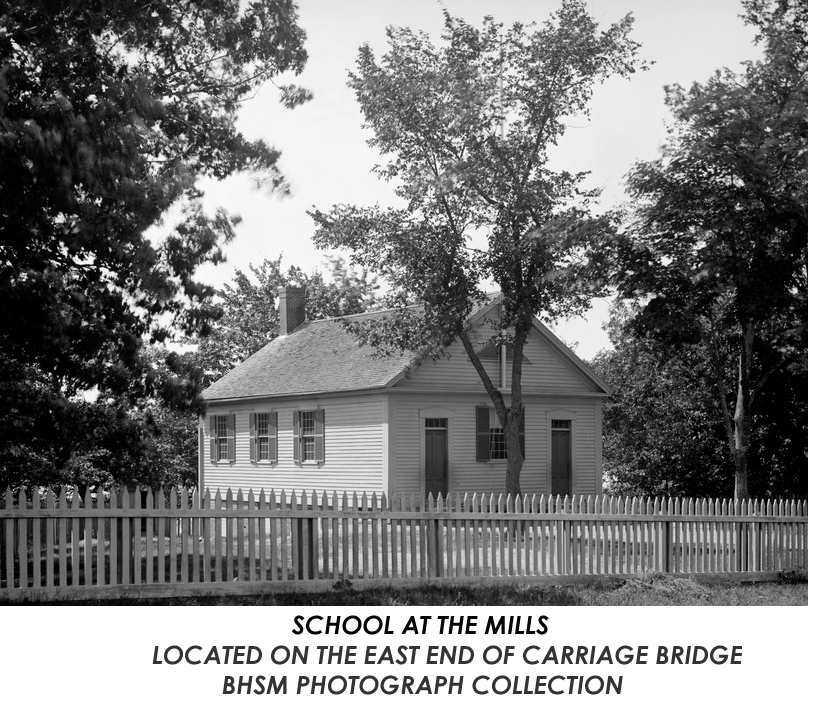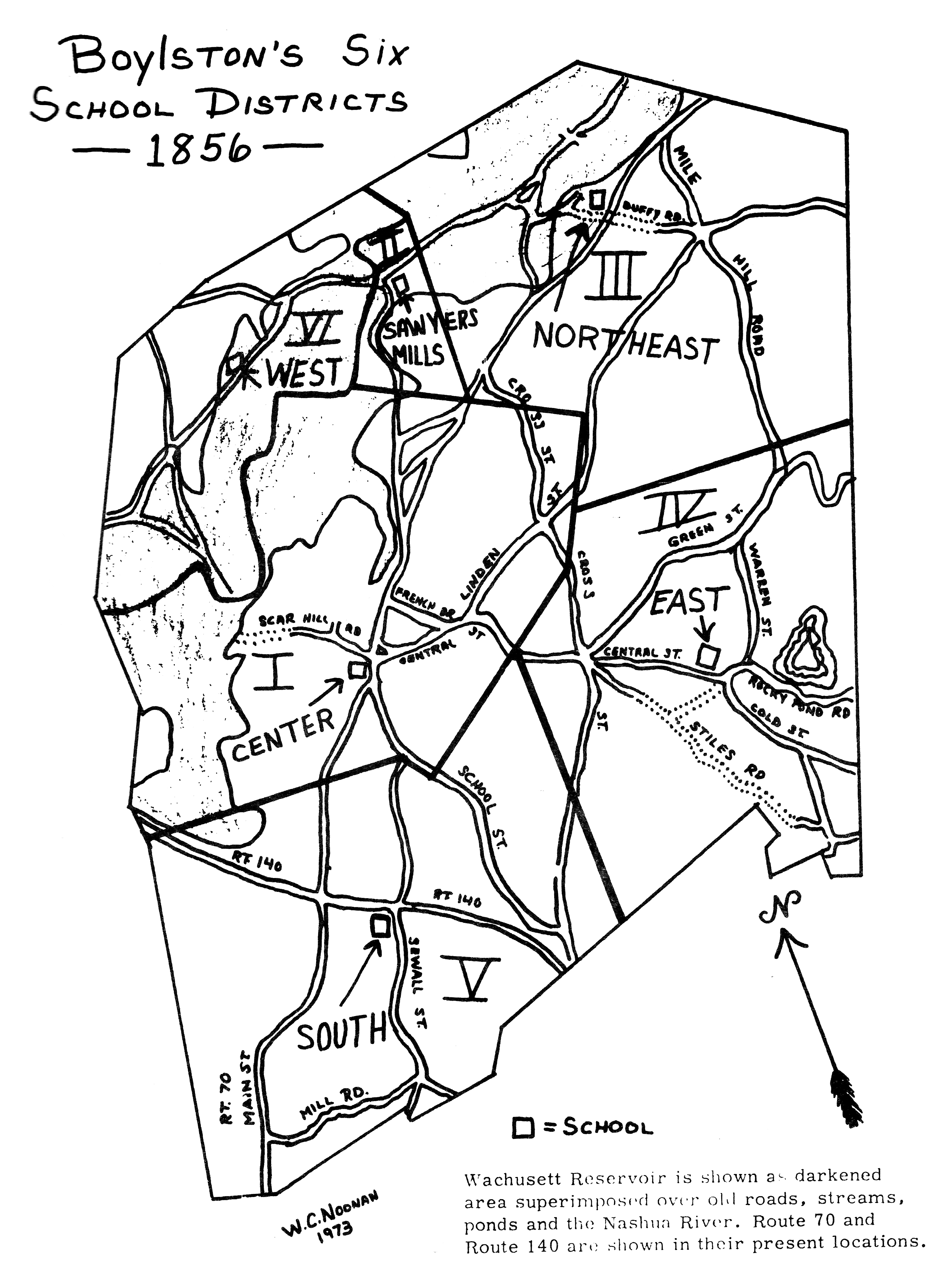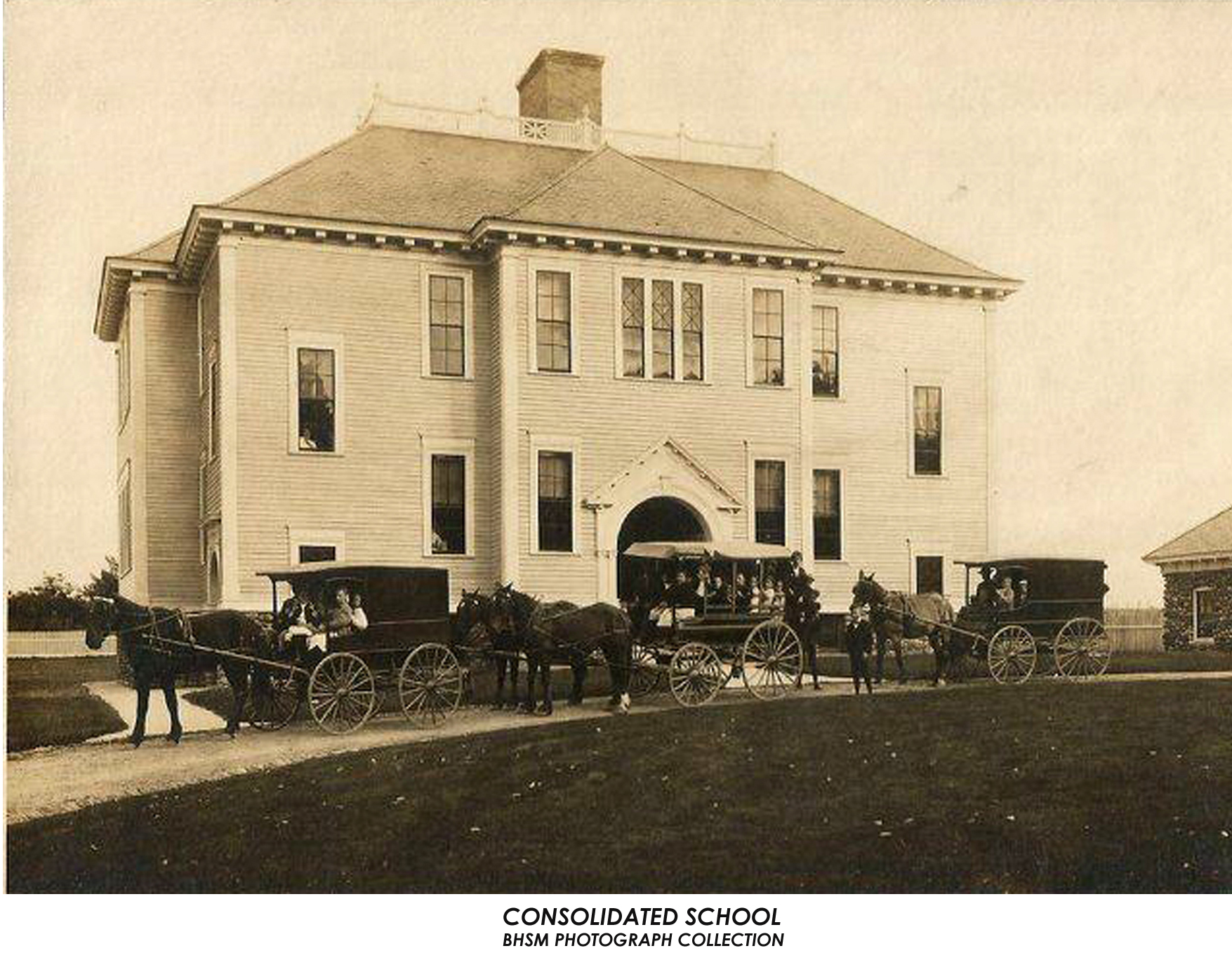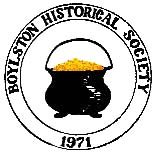Sawyers Mills School
Sawyers Mills School
by Judy Haynes
The village of Sawyers Mills was a thriving place in the early years of Boylston and was an area where one of our earliest settlers, Joseph Sawyer, settled circa 1713. He was from the Lancaster area, and Boylston was a part of that original land grant. Along the Nashua River he lived and built his saw mill. The village expanded with a grist mill, a lumber mill, and an oil mill processing neat’s foot oil, and eventually a cloth mill. Joseph’s son Aaron took over the milling and by Aaron’s death (1817) the estate covered 500 acres and included an area housing all of those mills, barns, and outbuildings. By 1862 the Clinton Company owned the mills, and they were then sold to the Lancaster Mills, a textile company. With mills came workers and families, and families meant children who should be schooled.
The first evidence of the need for a schoolhouse in the village was defined by the inhabitants of the West School District who stated in the 1849 School Committee Report that “in consequence of the increasing population at the mills, a better accommodation of the children in that village would be to form a new district whose school house shall be near the mills.” The Town Warrant of Boylston for the same year included Article 14 “To see if the town will create another school district in said town in the Sawyers Mill Village (so called) provided the district so created furnish a school house at their own expense..." While Article 14 was not voted on at that time, in 1850 a new sixth district, the North Center School District, was created for the Sawyer’s Mills village.

The School at Sawyers Mills Village was constructed in 1851 just east of the Nashua River. It was somewhat typical of the times, a one room schoolhouse which stood near the bridge, and at the corner of the road leading to Boylston Center, but while the main part of the school appears to be wood, it had a brick basement which contained a hall and was used for gatherings as well as worship services by the Roman Catholics until such time when they had a church built. The expenses shown for the school in various town reports indicate the schoolhouse was heated with wood.
The earliest School Committee Reports in our collection were handwritten and date from 1839, but thankfully they were printed in 1853, though without statistical tables of the six districts of Boylston until later publications. The later tables listed teachers’ names, terms, attendance, and enrollees. The school reports referred to the schools as “district” schools with a small “d,” but the more formal District System was voted on and passed by the Townspeople of Boylston on 1 April 1850. District I was The Center (also spelled Centre) School, District II was The North Centre School (located in Sawyer’s Mills village), District III was The North East School which was also known as Six Nations School, and was said to be the first school in Boylston. District IV was The South East School, District V was The South School, and District VI was The West School, situated to the west side of the Nashua River and the closest to the Sawyers Mills Village School
School areas were first known as squadrons or districts and covered approximately two-mile areas. A School Committee was appointed in 1803 by the Boylston Selectmen to oversee the schools and report on each school and its standing. The formal District System which had been instituted by vote in 1850 was abolished in 1867, then revived in 1871, and abolished again in 1883; however, every School Committee report from 1853 until 1893 still discussed schools under the district number designations. In 1894, however, the statistical tables no longer showed a district number, but listed the schools by name only. By then there were only four active schools in operation: the Centre School, the Sawyers Mills School, the North East School, and the South School.

Until 1850 the West school had a sizeable pupil enrollment as they were schooling many of the children from the Village of Sawyers Mills. This was a concern in 1849 as noted by the School Committee Report stating “that in consequence of the increasing population at the mills… a “better accommodation of the children in that village” was needed. Children from the village made up a sizeable pupil population of the West School, one they would lose if a village school was built.
In the 1851 School Report, the school later known as the Sawyers Mills School, was referred to as the “School at the Mills.” The Sawyers Mills School averaged 25 students per term for many years, but was always second only to Center School in District #1 for enrollment. Enrollment boomed with the clothing mills activities and by 1881 Sawyers Mills had a pupil count as follows: first term (spring) 18; 2nd term (fall) 29; and 3rd term (winter) 23. Only the Center School had more pupils with 35, 41, and 30, respectively. By 1893 though, Sawyers Mills School had the highest enrollment and required an assistant teacher.
The school at Sawyers Mills Village had consistently very good reports as shown by end of year examinations as well as good attendance. Attendance was deemed very important to the committee and problematic at several of the schools. The School Committee blamed in part the parents who allowed the children their absences. The reports seemed to preach to the parents to please keep the children in school. They even indicated that absence was an “evil” to education and the only valid excuses were “death or sickness.” In 1890 one person died of diphtheria in Sawyers Mills, but since it was confined to one family, the school did not close. While Sawyers Mills School had reasonably good attendance, at least one year reported that occasionally pupils would be taken out to work in the mills. This happened only to the oldest of the students and nearly all attending the school were under 14 as indicated in each table of statistics. While truancy was not stated as a problem in Sawyer’s Mills, it was the law. The first law to prevent truancy had been passed in Massachusetts in 1852 and it was the first compulsory attendance law in the United States thus, Boylston followed the law and had its Truant Officer with his annual report faithfully included in the School Reports.
Classes from the earliest days covered Reading, Spelling, Language/Grammar, Arithmetic, and Geography. The School Committee and Superintendent’s Annual Report of 1886 states that a class in Hygiene & Physiology was obligatory and enacted by the legislature in 1885, with reference to narcotics and alcohol/temperance to be included in the lessons. However, according to the Educational History, an earlier law requiring Hygiene & Physiology was also enacted by the Massachusetts Legislature in 1850, but with no emphasis on temperance. In any case Boylston’s School Committees was in tune with the legislation and recommendations, often quoting them in the annual reports. The 1877 school report found that “the study of history is almost wholly neglected.” It was suggested that during the Reading class a few pages of U.S. History be read each day. Gradually special classes such as Singing/Music (1885) and Drawing (1891) were introduced with a teacher for this specialty arriving once a week or every other week at each school.
In 1881 the Committee reported that teacher Alice Parsons “has had to teach English to a number of French children” at the Sawyers Mills School. The immigration provided available jobs at the clothing mill and on nearby farms while Canada, at the time, was suffering a depressions. . Parsons was complimented as being interesting to the children, and “obliging them to use the thinking qualities” instead of a “mere memorizing of facts.”
The committee would keep the same teacher from term to term when good results were evident. Several of the teachers had been to a Normal School and had specialized teacher training. Some, who had no Normal School education were equally successful; the committee noted those teachers would attend various Institutes and kept up with theories in education. The committee attributed achievements and good order due to the favorable relationships between teacher and students. Probably the longest serving was Mary (or Marie) Doyle who taught nearly ten years (1893 – 1901) at Sawyer’s Mills and was commended for her efforts. During the peak years when enrollment was high, Lydia Warner was hired as an assistant to Miss Doyle for 1895/6 to assist her with 44 scholars in spring, 37 in fall, and 47 in winter. Enrollment went to 45, 53, and 52 respectively the next year. Imagine today teaching that many students and covering material for seven grades in one classroom. An assistant was still needed in 1899. But by 1900 an assistant was no longer required as the expected “inundation of the waters” became known, and people sold their land and moved away. Much of the digging and clearing had already begun.
Nevertheless, a school was still open at Sawyers Mills with Miss Elizabeth Ryan teaching through spring term, 1903, the very last term. Enrollment of 14 pupils covered five grades. The experienced Marie Doyle was moved to teach at the Center School in 1901 which then had the higher enrollment. She was paid the most at $12 per week. Eleven dollars per week, $10, and $9 were paid to the other teachers that year. The end drew near for a school that had been one of the best. The Metropolitan Water Board had succeeded in their plan to acquire the land along the Nashua River and build the Wachusett Reservoir. The reservoir caused the closing of three schools: the West School, the Northeast School, and the Sawyer’s Mills School.
The County Commissioners Report to the Town of Boylston in December 1899 stated:
“The Wachusett Reservoir is to be built by an arbitrary act of public authority, regardless of expense, for the benefit of one section of the state [Boston, Massachusetts] to the great damage of another.."
For several years before 1903, It had become obvious that a new centralized school was desired to make the grades and education more efficient. The School Committee and School Superintendent began recommending a consolidated school in their reports until the town agreed and finally voted and approved a building at the March 1903 town meeting. A lot of land was then purchased from James A. Bigelow opposite the old cemetery. The new school was opened December 21, 1904.

Thus, ends any story of a Sawyers Mills School. Pupils from the former districts were transported to the new Consolidated School near the center of town and the Wachusett Reservoir became a reality.
________________
Acknowledgements:
Annual Reports of the Town Officers of Boylston 1853 -1905
Boylston Historical Series, Filgate, 2012 edition
County Commissioners Report to the Town of Boylston
Filgate, Nancy, editor
Reports of the School Committee to the Town of Boylston 1839-1905
“The Development of Education in Massachusetts, 1630-1930” Bridgewater.
